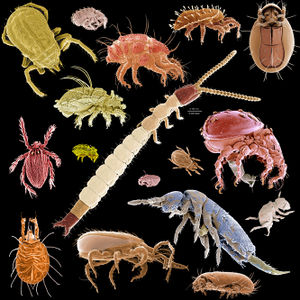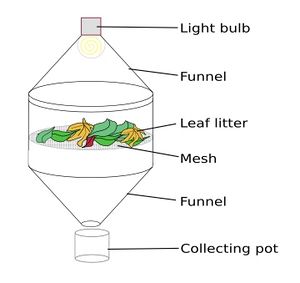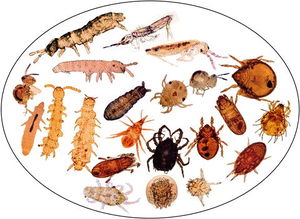Microarthropods: Difference between revisions
No edit summary |
m (The LinkTitles extension automatically added links to existing pages (<a rel="nofollow" class="external free" href="https://github.com/bovender/LinkTitles">https://github.com/bovender/LinkTitles</a>).) |
||
| (32 intermediate revisions by 3 users not shown) | |||
| Line 3: | Line 3: | ||
[[File:1_microarthropods_scaled.jpg|300px|thumb|left|Food Chain]] | [[File:1_microarthropods_scaled.jpg|300px|thumb|left|Food Chain]] | ||
Soil microarthropods include [[chelicerates]] ([[mite]]s, [[spider]]s, and [[pseudoscorpion]]s), [[myriapod]]s ([[centipede]]s, [[millipede]]s, and [[symphyla]]ns), [[crustacean]]s (small aquatic forms often found in water features), [[springtail]]s, and insects. Many groups do not have popular names; [[protura]]ns and [[diplura]]ns, for instance, are small soil arthropods related to insects. | [[Soil]] microarthropods include [[chelicerates]] ([[mite]]s, [[spider]]s, and [[pseudoscorpion]]s), [[myriapod]]s ([[centipede]]s, [[millipede]]s, and [[symphyla]]ns), [[crustacean]]s (small aquatic forms often found in water features), [[collembolas]] [[springtail]]s, and [[insects]]. Many groups do not have popular names; [[protura]]ns and [[diplura]]ns, for instance, are small soil [[arthropods]] related to insects. Microarthropods and other small soil animals are visible (sometimes barely so) but miniscule; most require some level of magnification for identification [8]. | ||
Much of the microarthropod group are discovered in most types of soils. A square meter of woodland floor could contain hundreds of thousands of individuals representing thousands of different species, mainly mites and [[collembola]]. Microarthropods have a substantial impact on the decomposition process in the forest floor and are important reservoirs of biodiversity in forest ecosystems | Much of the microarthropod group are discovered in most types of soils. A square meter of woodland floor could contain hundreds of thousands of individuals representing thousands of different species, mainly [[mites]] and [[collembola]]. Microarthropods have a substantial impact on the [[decomposition]] process in the forest floor and are important reservoirs of biodiversity in forest ecosystems. They also control the distribution and abundance of fungi in soil, and they stimulate microbial metabolic activity, thereby amplifying microbial immobilization or mineralization of nutrients [7]. | ||
Microarthropods form an important set of connections in [[food chains]]/webs. They feed on fungi and nematodes and are prey for macroarthropods such as spiders, beetles, ants, and centipedes. | Microarthropods form an important set of connections in [[food chains]]/webs. They feed on fungi and [[nematodes]] and are prey for macroarthropods such as spiders, beetles, ants, and centipedes. The diet of microarthropods is varied as some microarthropods function as [[decomposers]] and many others are predators of other small organisms. | ||
=Extraction Methods= | =Extraction Methods= | ||
In practice, soil microarthropod sampling involves the collection of soil which is taken back to the laboratory for extraction. Since microarthropods are too small and numerous to be sampled as individuals, pieces of habitat are collected and the microarthropods are then extracted from the collected samples via a technique of choosing. Most of the methods used for microarthropod extraction are either variations of the [[Tullgren funnel]], floatation in solvents, or filtration. For qualitative and quantitative studies of living soil microarthropods; one of the most popular method is Berlese-Tullgren extraction method [5]. The Berlese-Tullgren extraction method is the simplest one as it efficiently and rapidly extracts the microarthropods from soil samples in which soil animals are forced by a temperature gradient move down from the soil sample to the collection vessels. Once in the collection vessel, the [[organisms]] will remain in either water or alcohol to prevent them from escaping. | |||
[[File:tullgren.jpg|300px|thumb|left|Tullgren Funnel]] | [[File:tullgren.jpg|300px|thumb|left|Tullgren Funnel]] | ||
=Biodiversity= | =Biodiversity= | ||
Soils, including the deepest horizons and the [[rhizosphere]], constitute a huge reservoir of understudied biodiversity, yet our sampling techniques may be inadequate to assess the diversity and abundance of soil fauna. | Soils, including the deepest horizons and the [[rhizosphere]], constitute a huge reservoir of understudied biodiversity, yet our sampling techniques may be inadequate to assess the [[diversity]] and abundance of soil fauna. | ||
Temperate forest floors with large accumulation of organic matter support high numbers of microarthropods compared to tropical forests where the organic layer is thin. | Temperate forest floors with large accumulation of [[Organic Matter|organic matter]] support high numbers of microarthropods compared to tropical forests where the organic layer is thin. The thin layer where soil and litter meet is the most biologically active; many species of microarthropods thrive only in the interface between soil and litter. Others are found in deeper layers; these are often thinner, wormlike in form, with shorter legs than their counterparts in leaf litter [8]. | ||
Mites outnumber collembolans but these become more abundant in some situations. Among the mites themselves, the oribatids usually dominate but the Prostigmata may develop large populations in cultivated soils with a surface crust of algae. After cultivation asigmatic mites have been seen to increase dramatically. | Mites outnumber collembolans but these become more abundant in some situations. Among the mites themselves, the oribatids usually dominate but the [[Prostigmata]] may develop large populations in cultivated soils with a surface crust of algae. After cultivation asigmatic mites have been seen to increase dramatically. | ||
Soil arthropods are significant reservoirs of biodiversity. In an extensive review, reports show that at most 10% of soil microarthropod populations have been explored and 10% of species described. | Soil arthropods are significant reservoirs of biodiversity. In an extensive review, reports show that at most 10% of soil microarthropod populations have been explored and 10% of species described. | ||
| Line 28: | Line 28: | ||
=Role in Soil Ecology= | =Role in Soil Ecology= | ||
While soil fauna is generally acknowledged as being important for soil aggregation, direct empirical evidence is scarce for microarthropods, including mites and collembolans, the two most abundant and diverse groups. This is surprising given that these animals can occur at high densities, and given their role in the processing of organic matter via chemical, physical and biological mechanisms | While soil fauna is generally acknowledged as being important for soil aggregation, direct empirical evidence is scarce for microarthropods, including mites and collembolans, the two most abundant and diverse groups. This is surprising given that these [[animals]] can occur at high densities, and given their role in the processing of [[Organic Matter|organic matter]] via chemical, physical and biological mechanisms. | ||
Due to their relatively small body size and total biomass, which is lower than that of fungi, bacteria and other taxa such as nematodes and protozoa, microarthropods may rather indirectly than directly affect soil structure. However, in some cases the impact of the production of assumedly large amounts of organic material in form of eggs might play an important role as direct starting points for microaggregate formation. | Due to their relatively small body size and total biomass, which is lower than that of fungi, bacteria and other taxa such as nematodes and [[protozoa]], microarthropods may rather indirectly than directly affect soil structure. However, in some cases the impact of the production of assumedly large amounts of organic material in form of eggs might play an important role as direct starting points for microaggregate formation [6]. Many microarthropods, especially springtails and soil mites, are responsible for breaking down organic material into a form that bacteria can consume, and are fundamental to the creation of [[humus]] and the formation of soil [8]. | ||
In soils where fungi dominate, there are six mechanisms of interaction with microarthropods. Two control fungal distribution and abundance, namely selective grazing of fungi by microarthropods and dispersal of fungal inoculum by microarthropods. Four additional mechanisms stimulate microbial activity: (1) direct supply of mineral nutrients in urine and feces, (2) stimulation of bacterial activity by microarthropod activity, (3) compensatory fungal growth due to periodic microarthropod grazing, and (4) release of fungi from competitive stasis due to microarthropod disruption of competing mycelial networks [7]. | |||
=References= | |||
* [1] “Berlese Funnels - Collecting Methods - Mississippi Entomological Museum Home.” Camponotus(Tanaemyrmex) Castaneus (Latreille) , mississippientomologicalmuseum.org.msstate.edu/collecting.preparation.methods/Berlesefunnel.htm#.WvLuxUxFzIV. | |||
* [2] “Proper Soil Sampling Techniques.” Volusia County, www.volusia.org/services/community-services/extension/agriculture/proper-soil-sampling-techniques.stml. | |||
* [3] Christian, E., 1978. The jump of the springtails. Naturwissenschaften 65:495-496. | |||
* [4] Piper, Ross (2007). Extraordinary animals: an encyclopedia of curious and unusual animals. Santa Barbara, California: Greenwood Press. | |||
* [5] Bano, R., and S. Roy. 2016. Extraction of Soil Microarthropods: A low cost Berlese- Tullgren funnels extractor. ~ 14 ~ International Journal of Fauna and Biological Studies 3:14–17. | |||
* [6] Maaß, S., T. Caruso, and M. C. Rillig. 2015. Functional role of microarthropods in soil aggregation. Pedobiologia 58:59–63. | |||
* [7] Lussenhop, J. 1992. Mechanisms of Microarthropod-Microbial Interactions in Soil. Advances in ecological research. Vol. 23. | |||
* [8] Lavoipierre, F. 2011. Pacific [[Horticulture]] Society | Garden Allies: Soil Microarthropods. https://www.pacifichorticulture.org/articles/soil-microarthropods/. | |||
Latest revision as of 13:07, 10 May 2023
Overview
Soil microarthropods include chelicerates (mites, spiders, and pseudoscorpions), myriapods (centipedes, millipedes, and symphylans), crustaceans (small aquatic forms often found in water features), collembolas springtails, and insects. Many groups do not have popular names; proturans and diplurans, for instance, are small soil arthropods related to insects. Microarthropods and other small soil animals are visible (sometimes barely so) but miniscule; most require some level of magnification for identification [8].
Much of the microarthropod group are discovered in most types of soils. A square meter of woodland floor could contain hundreds of thousands of individuals representing thousands of different species, mainly mites and collembola. Microarthropods have a substantial impact on the decomposition process in the forest floor and are important reservoirs of biodiversity in forest ecosystems. They also control the distribution and abundance of fungi in soil, and they stimulate microbial metabolic activity, thereby amplifying microbial immobilization or mineralization of nutrients [7].
Microarthropods form an important set of connections in food chains/webs. They feed on fungi and nematodes and are prey for macroarthropods such as spiders, beetles, ants, and centipedes. The diet of microarthropods is varied as some microarthropods function as decomposers and many others are predators of other small organisms.
Extraction Methods
In practice, soil microarthropod sampling involves the collection of soil which is taken back to the laboratory for extraction. Since microarthropods are too small and numerous to be sampled as individuals, pieces of habitat are collected and the microarthropods are then extracted from the collected samples via a technique of choosing. Most of the methods used for microarthropod extraction are either variations of the Tullgren funnel, floatation in solvents, or filtration. For qualitative and quantitative studies of living soil microarthropods; one of the most popular method is Berlese-Tullgren extraction method [5]. The Berlese-Tullgren extraction method is the simplest one as it efficiently and rapidly extracts the microarthropods from soil samples in which soil animals are forced by a temperature gradient move down from the soil sample to the collection vessels. Once in the collection vessel, the organisms will remain in either water or alcohol to prevent them from escaping.
Biodiversity
Soils, including the deepest horizons and the rhizosphere, constitute a huge reservoir of understudied biodiversity, yet our sampling techniques may be inadequate to assess the diversity and abundance of soil fauna.
Temperate forest floors with large accumulation of organic matter support high numbers of microarthropods compared to tropical forests where the organic layer is thin. The thin layer where soil and litter meet is the most biologically active; many species of microarthropods thrive only in the interface between soil and litter. Others are found in deeper layers; these are often thinner, wormlike in form, with shorter legs than their counterparts in leaf litter [8].
Mites outnumber collembolans but these become more abundant in some situations. Among the mites themselves, the oribatids usually dominate but the Prostigmata may develop large populations in cultivated soils with a surface crust of algae. After cultivation asigmatic mites have been seen to increase dramatically.
Soil arthropods are significant reservoirs of biodiversity. In an extensive review, reports show that at most 10% of soil microarthropod populations have been explored and 10% of species described.
Role in Soil Ecology
While soil fauna is generally acknowledged as being important for soil aggregation, direct empirical evidence is scarce for microarthropods, including mites and collembolans, the two most abundant and diverse groups. This is surprising given that these animals can occur at high densities, and given their role in the processing of organic matter via chemical, physical and biological mechanisms.
Due to their relatively small body size and total biomass, which is lower than that of fungi, bacteria and other taxa such as nematodes and protozoa, microarthropods may rather indirectly than directly affect soil structure. However, in some cases the impact of the production of assumedly large amounts of organic material in form of eggs might play an important role as direct starting points for microaggregate formation [6]. Many microarthropods, especially springtails and soil mites, are responsible for breaking down organic material into a form that bacteria can consume, and are fundamental to the creation of humus and the formation of soil [8].
In soils where fungi dominate, there are six mechanisms of interaction with microarthropods. Two control fungal distribution and abundance, namely selective grazing of fungi by microarthropods and dispersal of fungal inoculum by microarthropods. Four additional mechanisms stimulate microbial activity: (1) direct supply of mineral nutrients in urine and feces, (2) stimulation of bacterial activity by microarthropod activity, (3) compensatory fungal growth due to periodic microarthropod grazing, and (4) release of fungi from competitive stasis due to microarthropod disruption of competing mycelial networks [7].
References
- [1] “Berlese Funnels - Collecting Methods - Mississippi Entomological Museum Home.” Camponotus(Tanaemyrmex) Castaneus (Latreille) , mississippientomologicalmuseum.org.msstate.edu/collecting.preparation.methods/Berlesefunnel.htm#.WvLuxUxFzIV.
- [2] “Proper Soil Sampling Techniques.” Volusia County, www.volusia.org/services/community-services/extension/agriculture/proper-soil-sampling-techniques.stml.
- [3] Christian, E., 1978. The jump of the springtails. Naturwissenschaften 65:495-496.
- [4] Piper, Ross (2007). Extraordinary animals: an encyclopedia of curious and unusual animals. Santa Barbara, California: Greenwood Press.
- [5] Bano, R., and S. Roy. 2016. Extraction of Soil Microarthropods: A low cost Berlese- Tullgren funnels extractor. ~ 14 ~ International Journal of Fauna and Biological Studies 3:14–17.
- [6] Maaß, S., T. Caruso, and M. C. Rillig. 2015. Functional role of microarthropods in soil aggregation. Pedobiologia 58:59–63.
- [7] Lussenhop, J. 1992. Mechanisms of Microarthropod-Microbial Interactions in Soil. Advances in ecological research. Vol. 23.
- [8] Lavoipierre, F. 2011. Pacific Horticulture Society | Garden Allies: Soil Microarthropods. https://www.pacifichorticulture.org/articles/soil-microarthropods/.


